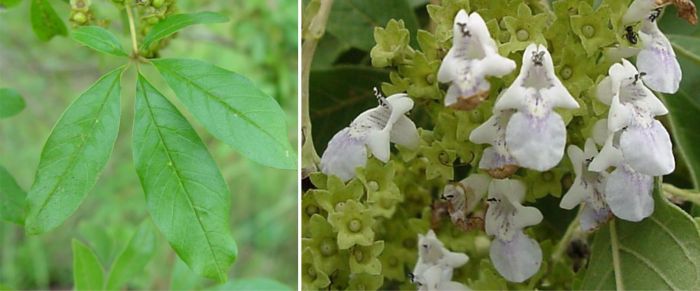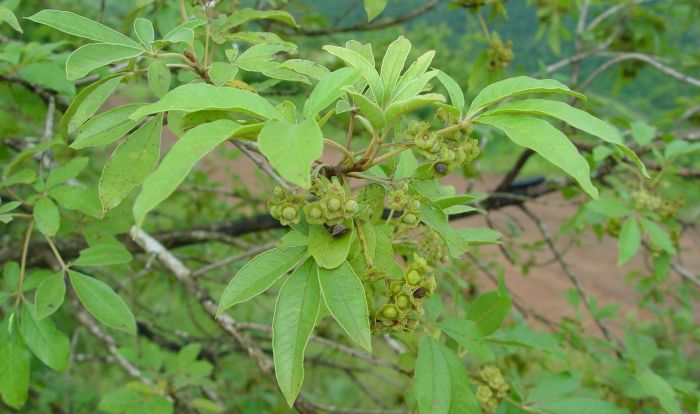Vitex rehmannii
Vitex rehmannii Gürke
Family: Lamiaceae
Common names: pipe-stem fingerleaf, pipe-stem tree (Eng.), pypsteelvingerblaar, pypsteelboom (Afr.), munyongatshifumbu (Tshivenda), umluthu (isiZulu), mokgale (Sepedi), manohani (Setswana), umkhosikati, mbhindvongo, bufufu (Siswati).
SA Tree No: 664
Introduction
Vitex rehmanni is categorized as a shrub and a tree and is endemic to southern Africa. It has yellow-green to olive-green, aromatic leaves and white to purplish flowers with a long stalk, in summer.

Description
Description
Vitex rehmannii is a shrub or small tree that can grow up to 9 m in height, with a trunk reaching a diameter of up to 300 mm. The bark of the tree is rough with a light grey to greyish brown colour. The leaves are palmately compound with 3–5 leaflets, yellow-green to olive-green, toothed in the upper half and with short hairs or no hairs. The flowers are 5-lobed with long stalks and purple or mauve lobes. The tree flowers in summer, between November and January. The fruits are pear-shaped, blackish when ripe.

Conservation Status
Status
Vitex rehmannii is currently assessed as Least Concern (LC) in the Red List of South African plants. This means that the species is not threatened and is not at a risk of becoming extinct.
Distribution and habitat
Distribution description
Vitex rehmannii is endemic to South Africa and Swaziland. In South Africa, it is found in Limpopo, Mpumalanga, KwaZulu-Natal, Gauteng and the North West. It is usually found in mixed bushveld, in stony or rocky areas with sandy soils. The tree has also been found in forest, savanna, or savanna woodland as well as in open woodland. Other trees of the species were found in stony hillsides, rocky outcrops, and in deep sands.

Derivation of name and historical aspects
History
The genus name Vitex is derived from the Latin word vieo, which means ‘to bend or to twist’ and refers to the flexible stems of some species. The species name rehmannii is derived from the surname of a Polish botanist and geographer Anton Rehmann (1840-1917), as an honour.
Ecology
Ecology
There is no available information on seed dispersal, animal or insect interactions or pollinators of Vitex rehmannii. The species is rarely studied.

Uses
Use
The wood of this tree is mostly used in construction, to make stools as well as for firewood. The leaves have been reported to have antimicrobial properties and are used to treat stomach ache, chest complaints and fits in Eswatini. The hollow stems are used to make pipes that are used to smoke tobacco.
Growing Vitex rehmannii
Grow
There is no information at present on the cultivation, growing or the propagation of Vitex rehmannii. Giving an educated guess judging by the natural environment where it grows, pipe-stem tree can be grown in sun or semi-shade, in rocky, sandy soils in the summer-rainfall region.
References
- Charters, M.L. 2006–2016. The Eponym Dictionary of South African plants. Published online at http://www.calflora.net/southafrica/1Titlepage.html
- Eswatini's Flora - siSwati Names and Uses. Accessed on 2021/01/21. http://www.sntc.org.sz/flora/clusagelist.asp?uid=2&pg=47
- Loffler, L. & Loffler, P. 2005. Swaziland tree atlas-including selected shrubs and climbers. Southern African Botanical Diversity Network Report No. 38. SABONET, Pretoria.
- Raimondo, D., Von Staden, L., Foden, W., Victor, J.E., Helme, N.A., Turner, R.C., Kamundi, D.A. & Manyama, P.A. (eds) 2009. Red list of South African plants. Strelitzia 25. South African National Biodiversity Institute, Pretoria.
- Tree SA. Vitex rehmanni. Accessed on 2021/01/21. https://treesa.org/vitex-rehmannii/
- Van Wyk, B. & Van Wyk, P. 2013. Field guide to trees of southern Africa. Struik Publishers, Cape Town, Johannesburg.
Credits
Thandy Makgolane
National Herbarium
January 2021
Acknowledgements: the author thanks Geoff Nichols for providing the images used to illustrate this article.
Plant Attributes:
Plant Type: Shrub, Tree
SA Distribution: Gauteng, KwaZulu-Natal, Limpopo, Mpumalanga, North West
Soil type: Sandy, Loam
Flowering season: Spring, Early Summer
PH:
Flower colour: Purple, White, Mauve/Lilac
Aspect: Full Sun
Gardening skill: Average
Special Features:
Horticultural zones








Rate this article
Article well written and informative
Rate this plant
Is this an interesting plant?
Login to add your Comment
Back to topNot registered yet? Click here to register.